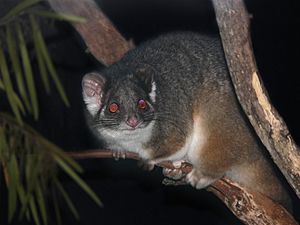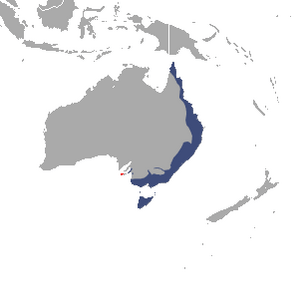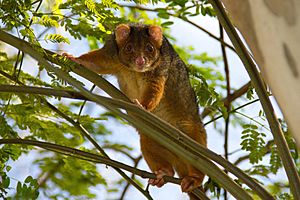Common ringtail possum facts for kids
Quick facts for kids Common ringtail possum |
|
|---|---|
 |
|
| Conservation status | |
| Scientific classification | |
| Genus: |
Pseudocheirus
|
| Species: |
peregrinus
|
 |
|
| Common ringtail possum range (except western ringtail possum (Pseudocheirus peregrinus occidentalis) range) (blue — native, red — introduced) | |
The common ringtail possum (Pseudocheirus peregrinus) is a small Australian marsupial. Its name comes from Greek words meaning "false hand" and Latin words meaning "pilgrim" or "alien."
These possums live in many different places. They eat various leaves from both native and introduced plants. They also enjoy flowers, fruits, and tree sap. Interestingly, this possum also eats a special type of droppings it produces during the day. This behavior is called caecotrophy, and it's similar to what rabbits do.
Contents
What Kind of Animal Is It?
The common ringtail possum is the only living species in its group, called Pseudocheirus. Other types of ringtail possums used to be in this group too.
One special kind is the Pseudocheirus peregrinus occidentalis, found in southwestern Australia. Some scientists think this might be its own separate species, Pseudocheirus occidentalis.
What Does It Look Like?
A common ringtail possum usually weighs between 550 and 1100 grams. It is about 30–35 centimeters long, not counting its tail. The tail is usually about the same length as its body!
These possums have grey or black fur. They have white patches behind their eyes and a creamy white belly. Their long, prehensile tail can grip things like a hand. It often has a clear white tip on the last quarter of its length. Their back feet are syndactyl, meaning some toes are joined. This helps them climb trees easily. The possum's back teeth, called molars, have sharp, pointed cusps.
Where Do They Live?
Common ringtail possums live along the east coast of Australia. They are also found in Tasmania and a small part of southwestern Australia. They prefer places with mild or warm weather. You won't find many in very dry areas.
These possums love forests with lots of thick bushes. Eucalyptus forests are a favorite home. Ringtail possums fill a role in their forests similar to how lemurs or squirrels live in forests on other continents. They are not as common or widespread as the common brushtail possum.
How Do They Behave?
Common ringtail possums are active at night (nocturnal). They are very good at living in trees. They use their gripping tail to move around and rarely come down to the ground. They talk to each other using soft, high-pitched, twittering sounds.
What Do They Eat?
The common ringtail possum eats many different plants from the Myrtaceae family. This includes the leaves, flowers, and fruits from shrubs and lower tree branches. Some possums also eat leaves from cypress pine (Callitris) and wattles (Acacia spp.). They might also eat plant gum or resins.
When they look for food, ringtail possums prefer young leaves over older ones. Young eucalyptus leaves have more nitrogen. However, the protein in them is harder to get because of natural chemicals called tannins. When they eat, their molars slice the leaves into small pieces.
The possum's digestive system has a special part called a caecum. This helps separate tiny food particles from larger ones. These tiny particles stay in the caecum for a long time. There, the plant material is partly digested.
What's unique about the ringtail possum's digestion is that the contents from the caecum go back to the stomach. This allows the possum to get more protein from its food. Animals like rabbits and pikas (which are lagomorphs) do something similar. The possum produces hard droppings at night, which it doesn't eat. But it produces soft droppings during the day while resting, and it eats these.
How Do They Get Energy?
Eating their caecal droppings also helps ringtail possums get enough energy. They get a lot of their daily energy this way. This special eating habit helps them get enough nitrogen (a key nutrient) from their food. Without it, they would need to eat much more.
The possum's body is very good at recycling nutrients. This recycling also helps the possum save water and urinate less. Eating these special droppings allows the possum to live on eucalyptus leaves, which are not very rich in nutrients. This is especially important when mothers are feeding their young.
Where Do They Sleep?
Common ringtail possums often live in groups. They build shared nests, called dreys, from tree branches. Sometimes, they use hollows in trees. A group usually includes an adult female, an adult male, their young, and older offspring from the previous year.
A group of possums might build several dreys in different spots. Ringtail possums are protective of their territory. They will chase away any other possums that don't belong to their group. A group is very attached to its home area. Dreys are important for the survival of young possums once they are too big to ride on their mother's back.
How Do They Have Babies?
Like other marsupials, the common ringtail possum carries its young in a pouch. The babies grow inside this pouch. The mating season can be different depending on the area, from April to December. Most babies are born between May and July.
A female possum can have babies again if she loses her first litter early. The average litter size is two babies, but sometimes they have three. Young possums grow slowly because their mother's milk is not very rich in fats. As the babies grow, the mother's milk changes. When the young first come out of the pouch, they start eating more solid foods.
The long time spent feeding on milk might give the young more time to learn important skills. They learn how to climb and find food in the trees while still in the safety of the communal nest.
Babies can start making sounds and open their eyes when they are about 90 to 106 days old. They leave their mother's pouch when they are around 120–130 days old. However, they often continue to drink milk until they are 180–220 days old. Both male and female possums can have their own babies in the first mating season after they are born.
Are They in Danger?
The number of common ringtail possums dropped a lot in the 1950s. However, their populations seem to have grown back recently. Because they live mostly in trees, they are greatly affected when forests are cut down in Australia.
They are also hunted by the European Fox, which was brought to Australia. In suburban areas, they can be hit by cars or killed by pet cats and dogs.
Images for kids
See also
 In Spanish: Falangero de cola anillada para niños
In Spanish: Falangero de cola anillada para niños






